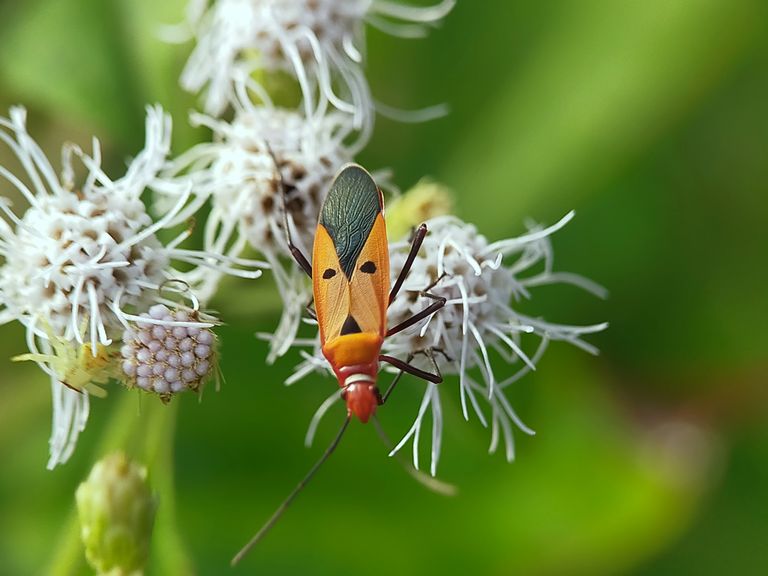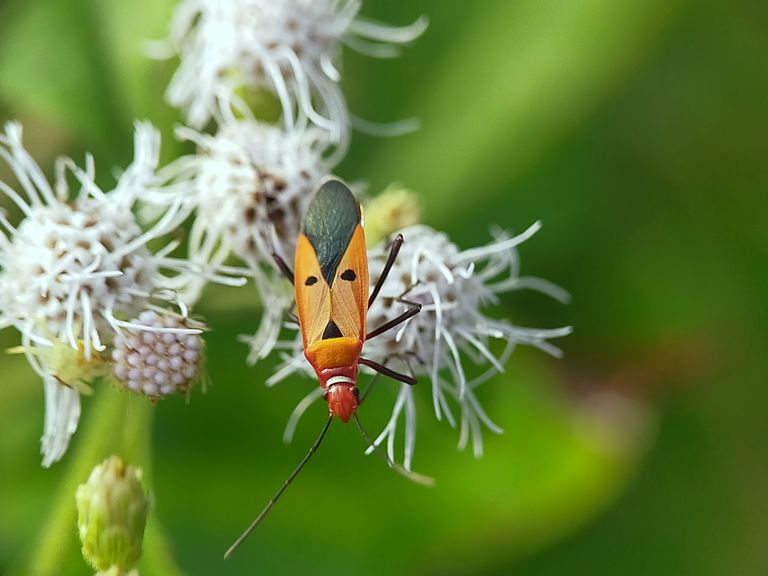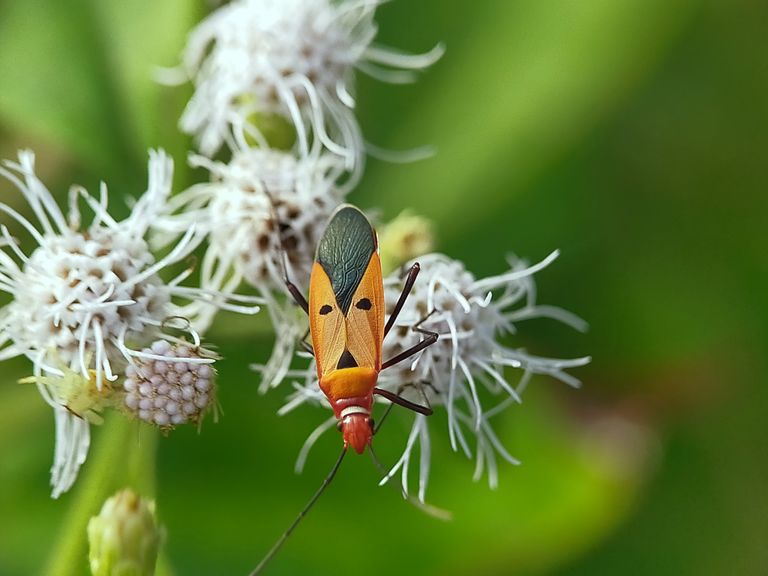Good afternoon everyone for all of our friends who are at Blurtter and have been joining Blurtter for a long time, hopefully we are always healthy and can always carry out activities as usual. So on this occasion I want to write a little bit about Dysdercus Cingulatus | Photography | Macro hopefully later it can become a memory for myself, and for other friends who are already married, don't forget to also give directions and input if later in my writing there are still words- words that are not polite, therefore I apologize once again.

Pucung (Dysdercus cingulatus) or Red Cotton Bug is a pest, both young and adult, that attacks plants from the Malvaceae family (cotton, roselle and okra) and the Bombacaceae family (kapok). The body of the pucung is red with a length of 11 - 17mm long and 4.5mm wide. On the back of the head and belly there are white and black stripes. On its brown wings there are a pair of black spots. The nymphs are bright red and live in groups. Pucung's eggs are usually placed under the host plant or in a protected place in a small hole. The hole is then covered with soil or litter. The number of eggs is about 100 which are divided into 8 groups. For its development, eggs need high humidity. If it's dry, the eggs will die. Eggs hatch in 5 days at a temperature of 27 degrees Celsius, or 8 days at a temperature of 23 degrees Celsius. Nymphs will experience several times the process of molting or ecdysis. Each stage between molting is called an instar. Nymph Bapak Pucung had 5 instars. The color of a fully grown nymph is red with black spots on its wings. Nymphs 10-15 mm long. The duration of the nymph period is 21 days at 27 degrees Celsius, or 35 days at 23 degrees Celsius. The mating period for male pucung is 2-6 days and starts laying eggs 3-8 days later. Tachinid parasitic flies are one of the natural enemies of male pucung which attacks nymphs from the fifth instar and adult male pucung. This fly lays its eggs on the body of the nymph or adult male pucung. In addition to the Tachinid parasitic fly, predators from Reduviidae (genus Phonoctonus) are also natural enemies of the male pucung. The shape and appearance are almost like the pucung's father, it's just that his body is shorter. These predators are common in Africa.

Superregnum | Superkingdom/Domain: Eukaryota Whittaker & Margulis, 1978 – eukaryotes (eukaryotes); organisms having complex cells enclosed in membranes, including animals, plants, and fungi—most of which are multicellular—as well as a variety of other micro-organisms that are not animals, plants or fungi that are classified collectively as protists (many of which have single cells or are unicellular) . Other organisms, such as bacteria, that lack nuclei (cell membranes) and other complex cell structures are called prokaryotes. The characteristics of eukaryotic cells include eukaryotic cells having a larger size than prokaryotes and having sub-cellular parts called organelles and a cytoskeleton which consists of microtubules, microfilaments and intermediate filaments. In contrast to prokaryotes, eukaryotes' DNA is stored in a collection of chromosomes that are stored in nuclei which are encased in the nuclear membrane. In addition to carrying out asexual cell division, most eukaryotes can also reproduce sexually through the process of cell fusion, which is not found in prokaryotes.Regnum | Kingdom: Animalia Linnaeus, 1758 – Animals or animals; the main group of eukaryotic organisms that have many cells (multicellular) organized in different functions (tissues). All animals are also heterotrophs, meaning they cannot make their own energy, but must take it from their surroundings.

The characteristics of animals or animals include having many body cells (multicellular), heterotrophic, the cells do not have cell walls that support the body strongly, can move actively, mostly reproduce sexually, have various respiratory organs depending place of life, need food for the body and develop etc.
Phylum: Arthropoda Latreille, 1829 – arthropods (arthropods); invertebrates (invertebrates) that have an external skeleton, the body is divided into several parts, and other additional limbs, is the largest phylum in the animal world where nearly 90% of all types of animals known to people are Arthropods, including insects, spiders, shrimp, centipedes and other similar animals. The characteristics of Arthropods include a segmented body with paired segmented limbs; has bilateral symmetry (has top-down, front-back); has an outer skeleton or exoskeleton with chitin; has an alimentary canal like a pipe with mouth and anus; have an open circulation system; The nervous system consists of an anterior ganglion or brain which is located above the alimentary canal, a pair of connections that pass from the brain around the alimentary canal and a ganglion nerve cord which is located below the alimentary canal; removal of waste or excreted substances usually by the malpighian tubules and the excretory material passes out through the anus; breathing or respiration with gills or trachea and spiracles; do not have cilia or ne.

Several small creatures seem to be engrossed in crawling on a vanilla tree at Kebun Lintang Panglipuran, a community in Yogyakarta which is engaged in environmental conservation. The creature is a striking orange color with several black dots on its back. "Here there is a song, his name is Bapak Pucung," said the head of the Kebung Lintang Panglipuran community, Acil, in the middle of last week. A very cute name for an insect. But reality is not as funny as the name and shape of this insect. Acil told me that in the past he often met Mr. Pucung in the garden around the house. But now, it is very rare for him to see the father of the pucung or the world of western science calls these red cotton bugs. Even Acil, who struggles with the garden almost every day, rarely sees him, how about people who only work with keyboards and laptop screens every day? Not long ago, Acil also had the chance to see a father-in-law, but not in the leaves as usual, but on the wall of a building. . "I was sorry yesterday to see Mr. Pucung crawling on the cement wall. What's wrong, can't find cotton plants?” he said at the same time as informing that papa pucung likes to perch on cotton trees the most. Insect expert from the Bogor Agricultural Institute (IPB), Damayanti Buchori said that papa pucung is indeed very rare. "If it's rare, that's for sure," he said when contacted yesterday. The main factor that makes the father of the pucung less and less is none other than the less and the destruction of their natural habitat. Forests are turned into agricultural land, and agricultural land is again converted into industrial and residential areas. So that in general the reduction of pucung in nature is caused by changes in land use. "Besides that, the use of pesticides can also kill these insects," he explained. The distribution of papaya pucung is actually quite wide. He can live anywhere, on farmland, open fields, to forests.

But if it is attacked with pesticides, it is certain that he will die too. "In the past there were quite a lot of them in the Botanical Gardens, but now they are hard to find," said Damy, as Damayanti is known. Generally, father pucung will marry in these months, April and May. Interestingly, pucung fathers can make love for a very long time, up to hours or even days. "It can take 12 hours to 7 days, so it looks like a dragonfly," said Damy. After the male pucung transfers sperm, he will not immediately leave the female. This is a form of protection for the female so that no other male marries her during the egg-laying period. Pucung is more widely known as a pest that will prey on farmers' crops. But what needs to be understood, according to Damy, there are several types of pucung sires, and not all of them are pests. There are pucung sires who are herbivorous, that is, they eat plants, while others are predatory species. Mr. Pucung, who is a type of herbivore, is usually a pest of farmers' crops. But for Mr. Pucung, the type of predator and rotten eater actually can actually provide benefits to the world of agriculture. "For the predator, he is important for farmers because it can attack caterpillar pests," explained Damy. also for farmers, Damy said they had to be smart in identifying these insects. Pucung predators whose role is to prey on caterpillars are more vulnerable to extinction, while herbivorous species are more difficult to become extinct as long as their host plants are still around.Then how can this pucung father survive and even be sustainable? The answer is of course by improving their natural habitat or at least suppressing land conversion. "And of course for the world of agriculture as much as possible to reduce or even no longer use chemical pesticides which will not only destroy pests, but also other insects that have an important role for the environment," said Damy.

Plant protection is an effort to prevent, reduce damage, reduce losses to plants or parts of them that are cultivated or needed by humans, starting from land preparation, harvesting until the results are received by consumers. The barrier to plant protection is a nuisance, namely the causative agent of changes in plants that are detrimental. One of these pests is pests. Pests are animals that disturb or cause damage to plants. There are many types of animals but in this practical we will discuss Arthropods. Arthropods (in Latin, arthra = segment, book, segment; podos = leg) are animals that have the characteristics of jointed, jointed or segmented legs. These segments are also present on the body. Arthropod bodies are bilaterally symmetrical and classified as triploblastic coelomates. Arthropods are the largest phylum in the animal kingdom and include insects, spiders, shrimp, centipedes and other similar animals. Four of the five (living today) animal species are arthropods, with over one million known modern species and a fossil record that goes back to the early Cambrian. Arthropods are common in marine, freshwater, terrestrial, and aerial environments, and include various symbiotic and parasitic forms. Nearly 90% of all known animal species are Arthropods. Arthropods are considered to be closely related to annelids, an example of which is Peripetus in South Africa. Phylum Arthropoda partially serves as prey for a number of predatory animals which consist of other arthropod and non-arthropod species. Fish and lizards eat mosquitoes, large frogs eat scarabidae, mynah birds eat grasshoppers, ducks eat leafhoppers and so on. Fish Gambusia affinis for example, has been widely used in various places in the world to control mosquito larvae.

Some predatory arthropods use mouthparts to bite and chew their prey, such as mantids, dragonflies and beetle bugs. Others, such as Hemiptera, Neuroptera larvae, flies and certain mites, use mouthparts and suckers to consume the bodily fluids of prey. Pests are organisms that are considered harmful and unwanted in human daily activities. Although it can be used for all organisms, in practice it is most often used only for animals. Animals can also be called pests if they cause damage to natural ecosystems or become agents of spreading disease in human habitat. Arthropods are the largest phylum of all animals that cause plant pests (Bambang, 2012). More than 75% of the animals we know belong to this phylum, and 990% of them belong to the class Insecta (Hexapoda ± 67.5% of the total animals). The characteristics of the phylum Arthropoda consist of segments that can be differentiated into two or three regions, bilaterally symmetrical shapes, and their appendages (aspendiks) are also segmented and in pairs. Two important classes cause plant pests, namely the Insect (Hexapoda) and Arachnida classes (Bambang, 2012).
Arthropods in the animal world are the largest phylum in the world. Four of the five subsets of animal species are arthropods, with over one million known modern species and a fossil record that goes back to the early Cambrian. The number of species is about 900,000 species with many variations. This number is approximately 80% of the animal species known today. Arthropods can live in fresh water, sea, land, and practically all of the earth's surface is covered by these species. Arthropods are considered to be closely related to annelids, for example Peripetus in South Africa (Anonymous 1, 2012). Medium-sized, light to dark brown in color, has thick protective skin that lives underground, with a modified hoe-shaped forelimb for digging. and swimming.
These animals are active at night (nocturnal) and in winter do hibernation. During the mating season, these animals can produce sounds through a mechanism similar to that of a cricket (with a stridulation organ), but with a much different sound. His voice is monotonous, without pause, and very disturbing hearing. When his hiding hole is approached, he will stop making noises but will start again once the distraction passes.
Ground dogs are animals that are rarely seen because they prefer to hide in holes and are active at night looking for food. Preferred habitat is dry fields, yards, and grass fields. These animals can be found everywhere, except for areas near the poles of the earth.












This is all I can say more and less I apologize, hopefully it will be useful for me, and hopefully it will be useful for all readers in general, thank you for visiting my blog, don't forget to follow and vote for my posts. , and one more thing, don't forget to share this post with other friends.
Thank you for visiting my blog, don't forget to follow and vote for me to post, and others don't forget to share this post with other friends.
Greetings to all on Blurtter....
Congratulations, your post has been curated by @scilwa, a curating account for @R2cornell's Discord Community.
The flowers look beautiful and the big has such details.
** Your post has been upvoted (4.38 %) **
Curation Trail is Open!
Join Trail Here
Delegate more BP for bigger Upvote + Daily BLURT 😉
Delegate BP Here
Upvote
https://blurtblock.herokuapp.com/blurt/upvote
Thank you 🙂 @tomoyan